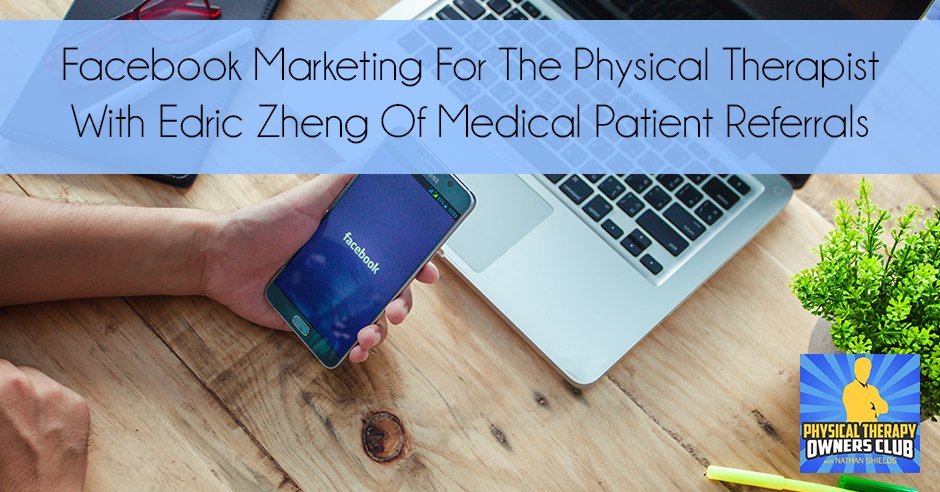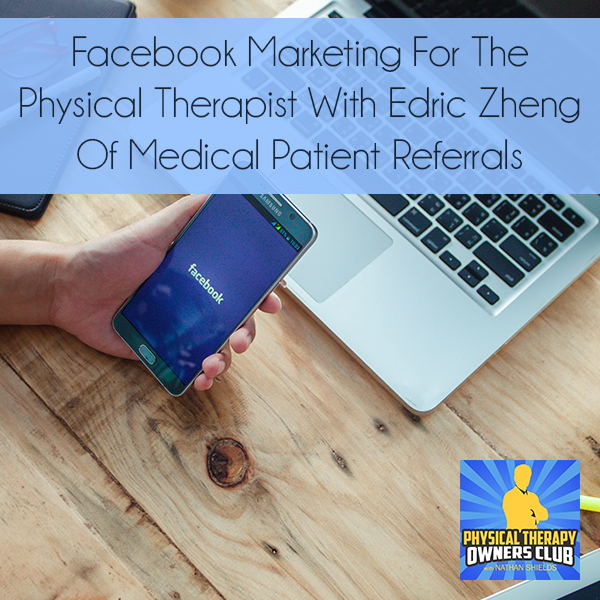
Social media marketing and advertising may be new for many physical therapists, but amidst the COVID-19 crisis, it is a marketing avenue that physical therapy owners need to consider. Joining Nathan Shields today is Edric Zheng of Medical Patient Referrals. Edric provides some of the basics about the why, how, and what is best to do when it comes to marketing on Facebook. Stick to the end for useful strategies in making irresistible offers, generating good content, broadening your audience, building a database and many more.
—
Listen to the podcast here:
Facebook Marketing For The Physical Therapist With Edric Zheng Of Medical Patient Referrals
My guest is Edric Zheng out of New York. He is with Medical Patient Referrals and he is an expert on social media marketing. I thought it’d be appropriate to bring him on, as owners have the time to consider their digital presence, the marketing that they do digitally, especially as we’ve been forced in that direction with the Coronavirus pandemic. First of all, Edric, thanks for coming on.
Marketing is only as powerful as your sales process. Click To TweetThank you, Nathan, for having me. I appreciate it.
Tell us a little bit about you, Edric and what you do for physical therapy owners, but also a little bit about your backstory and what got you to the point where you are now.
What I do is I set up a direct access patient generation system using Facebook ads to help them acquire new patients with social media and to take advantage of all this traffic they have available to them. My background is I’ve spent a few years in digital marketing, learning copywriting, running ads, and creating profitable campaigns. Also, spending a ton of my own money trying to figure things out for my eCommerce products as an affiliate in my previous life for other health companies and nutraceutical products. That’s how I got good at Facebook ads. I’m using those skills and taking it to help physical therapy owners with their patient acquisition systems and processes.
You’ve been spending a lot of time trying this, trying that, and refining content when it comes to Facebook ads. Why specifically do you focus on Facebook ads? Why are Facebook ads beneficial for physical therapists?
The reason why I focus on Facebook ads in the past was there’s so much opportunity there. Almost everyone that I know is on Facebook. Probably the same for yourself as well.

It’s probably two billion Facebook users or something like that on my side of the country?
People spend 30 minutes to two hours a day every single day on social media and the biggest growing demographics on Facebook are older people, over the age of 45. People are getting on so they could spend more time connecting with their family and look at photos of their children and things like that.
How did you utilize Facebook to drive direct access and patient generation?
What do for a client specifically or for my own company?
We want to be more PT specific. What do you do specifically for physical therapists to help them get direct access and patient generation? To some extent, we already have some direct access capabilities with physical therapy.
It all started with creating an irresistible offer for someone to want to come in and start a conversation with you. For example, it could start with maybe like a free consultation offer if you want to be super basic or free discovery visit, a second type of offer. It could be a workshop if you haven’t experienced hosting those types of things. It could be something super unique that you do and that no one else has ever seen before, like a free laser therapy session or something like that. It all started with coming up with an irresistible offer and then putting that on Facebook.
Physical therapy only needs to be specific or at least have a niche in which they can offer or somehow be able to share some of their knowledge base in order to gain that traffic and that interest.
When it comes to paid advertising, all you need is an ad text and an offer and you can start promoting that to almost whoever you want. You can start showing your offers and what you have to offer, the value that you can provide. You can start showing that to thousands of people if you have a couple of bucks to spend on Facebook.
With the number of people on social media, especially Facebook, during the COVID-19 crisis, it's an opportunity to gain a bigger audience. Click To TweetWhen I consider Facebook and talking to some of the marketing specialists, you want to get that patient in front of that patient as much as possible so that they click and buy or sign up for whatever offer you’re providing. There’s added value in simply gaining an email address and that’s building your list so you can send them future offers.
Getting an email address means that this person is interested in what you have to offer. It means that this person has back pain, knee pain or maybe has been involved in a motor vehicle accident or just has gotten out of surgery. They’re looking for related content. They’re looking around and they’re trying to find out who they can trust. If they’re on your email list, that means you have a line of communication with them where you can continuously provide value, educate them, and build that trust until they’re ready to come in and start a conversation with you or get the help that they need.
How does someone go about creating a successful marketing campaign on Facebook? What process do you recommend they go through?
If you wanted to, physical therapy owners can look at the different clinics in their city. Go on their Facebook pages and look at their ads that they’re currently running because that’s all public information that Facebook has made available to all advertisers to promote transparency. Being able to reverse engineer what’s already out there and what’s been running for a long time is probably the best way to start to do what’s already working.
How long do you recommend someone keep a Facebook ad up before they determine if it’s successful or not? Do you give it 2 or 3 days or do you give it 2 or 3 weeks before you look back and assess what the statistics are?

Since we have a lot of data already on Facebook ads, a KPI that physical therapy owners should look out for is the cost per lead metric. If they’re seeing their cost per lead go above $20, pause that ad and then to try again. Try a different offer, image, video, and angle. You want to try and get your cost per lead to around $10 because that’s where we know that you can have a lot of success if you can get there.
You’re saying $20 is the point at which you want to reconsider what you’re offering and what that looks like in the design and whatnot. When you say $20 per lead, that’s not necessarily a converted lead. That’s just simply $20 per lead.
That $20 is just someone who’s seen your ad, who’s given you their name, email, phone number, and is interested in whatever you have to offer on Facebook, be it a free consultation or a $21 evaluation or something like that.
You want to keep that number then below $10, is what you’re saying?
Yes, if you can keep it around $10, that is ideal because you’re not going to convert every single lead. That’s why you want to have a good amount of leads coming in at a solid price.
What are some of the most successful things someone can do as they’re setting up this strategy? What are some of the components of having a successful Facebook strategy?
For us, it always boils down to four things. Number one is your offer. What do you have to offer to get someone to want to come in or give you their information? That’s probably the most important thing. Number two is your creativity, which could be your image, a video or a testimonial that you’re attaching to that Facebook ad. That’s the second thing that people pay attention to. The third thing is your headline. Does it stop people from scrolling on social media? Does it get them to pay attention to what you have to say? The fourth thing is your body text. It’s whatever else you want to put into the Facebook ad and things that you want to say to keep them reading in on your Facebook ad. Whatever you write in your ad, it has to be whatever the conversation that the person is already having in their head. If you can answer that conversation and you can put that in the text format, you’re going to have a lot of success.
Do you find more success with video-based advertisements versus those that are simply text?
For sure. Video allows you to build a lot more rapport and a lot more trust that you can’t do with photos or with text.
How long should a video like that be? Do you have any recommendations?
If you’re going after an audience that doesn’t know who you are yet and people around your city, it’s maybe around 3 to 5 minutes providing value and educating people so they know that they can trust you and they can use what you have to say.
It’s an obvious answer but I’m sure in the body of the text, you’re wanting to refer them over to the landing page and a YouTube channel that you might have generated or other social media as well?
If you take them to a landing page, you can sell them some more, you can provide some more testimonials, and you can tell them more about your product, whatever you have to offer. It gives you another chance to sell them again and to qualify someone before they come into your funnel.
Effective advertising starts with an irresistible offer for someone to want to come in and start a conversation with you. Click To TweetFor me, creating content is my biggest fear. I can do it and I’d do it, but for someone who isn’t into developing that content, how would you guide them to make an irresistible offer that gets that client or that potential lead to reach out?
You have to put yourself in the perspective of your end client or your end customer and think about what is it that they want and what they find valuable. Put yourself in their shoes and think about whatever it is they would find useful. I would test that as an offer or a content to give away.
One of the books that I refer to is called Building a StoryBrand by Donald Miller. Interestingly, he recommends the same thing. When you’re advertising to somebody, you don’t want to come across as the hero in their story. If you’re advertising to somebody, they want to be the hero of their own story and you want to be essentially the guide like the Obi-Wan Kenobi that takes this person who doesn’t know their strengths and what they’re capable of and develops them. That way, they can become the true hero. That’s good advice. What you’re saying is that you want to talk to them as if you are the guide, but not the hero to their story. We have to remember as physical therapists that we can’t use our jargon, our vocabulary, especially the specifics. You want to get down to their level and talk about, “Do you have back pain that’s keeping you up at night?” Without getting into the technicalities of it, per se. “We have the four things that you need to do to sleep better.” Something like that. By saying that, do you find that content that has a list of the 4 or 5 things or how to blank that kind of thing? Is that helpful?
Yes. Those types of content always do well. A good way to know if your video content is doing well is there’s a metric you can look at on Facebook ads. It’s called Cost per ThruPlay, and that’s how much it cost you to get a fifteen-second video view of your ad. If that’s under $0.06, that piece of content is good because that’s another good metric to look at in your Facebook ad.
These are all metrics that you manage via Medical Patient Referrals but it’s something that people can also look at themselves if they are admins on their page?
Exactly. These are numbers that we’ve found over time to establish a good baseline for success.
When someone’s considering Facebook ads, buying ads and putting them out there, should they have more than one going at a time or just stick with one and see how it goes? What kind of mindset should they have as they’re considering purchasing Facebook ads?

They should definitely have more than one ad running at a time because this way, you can see what ad is performing better and why it’s performing better. Let’s say you run two ads at the same time. With one ad, you’re using a picture of a knee and the second ad is you’re talking about the back. Maybe the cost per lead with the back is half the price of the knee. You’re getting more bang for your buck, then you’re going to focus more on the back end and do as much as you can with that.
Do you find that some of your clients are having more success with Facebook ads during the slowdown, COVID-19 because people are more engaged in social media and Facebook itself?
The cost of advertising is definitely cheaper because a lot of people have quit and dropped out of the race. That leaves room for people who are still willing to try, adapt, and do new things. It gives them more breathing space since everything is cheaper. We’re still generating increases in new leads. We just have to change up the angle a little bit. Instead of advertising in-person consultation, what we’re doing is we’re advertising a free discovery call or a free phone conversation, which leads to a virtual evaluation, which leads to a virtual rehabilitation program.
What would be your tip or advice for people to get those leads to convert? Is there some secret or magic that you like to consider when it comes to converting those people?
Number one is the quality of your campaign. Having yourself on video, getting the patient testimonials on video and putting that into the ad. Also, calling out who it is you’re looking for. The pain that they’re having, putting down into the text, and stepping into their head and into the conversation that they’re having will not get you that qualified increase. Number two is when you do generate that inquiry, you can’t wait three days later to call them. You have to try and get to that inquiry right away. Setting up notifications when you generate that lead and having someone in charge of that process and calling them right away when they’re still hot, still super interested in what you have to offer, and that conversation is still going on in their head.
The cool thing about you is we talked a lot about getting patient referrals and leads. Sometimes, those leads take multiple touchpoints. It’s not common that you’re successful with just one touchpoint and the patient converts. That’s why it’s cool that you recommend more than one going out at a time. You can get your Facebook ads down to a certain locale, community, and demographic. Once you develop that community, then you can hone in on the issues that are arising in that community. Your content and your output can be specific. That’s when it seems like it’s more powerful in the capabilities of converting the increase, would you say?
If you’re advertising to somebody, they want to be the hero of their own story and you want to be the guide. Click To TweetDefinitely.
Have you also used any of this for recruiting purposes? Because I see the capability of physical therapy owners using Facebook ads to recruit for other physical therapists, especially when a lot of physical therapists are out of work to recruit physical therapists via Facebook ads. Have you done that in the past or do you see the possibility there?
I’ve done a little bit in the past as a small test but that didn’t work out too well because we’re just targeting like a small population. The cool thing with Facebook is you can target by what they put in their Facebook profile. If they put physical therapist, you can target specifically only physical therapists that live in this specific city within 30 to 40 years old, if that’s the age range you’re looking for.
Can you also advertise to a certain locale or can you advertise the multiple states in your region?
Yes, you can choose exactly where you want the ads to show and who you want to see the ads.
I bring that up because I see that as a potentiality, even though you haven’t done a lot of it yourself. It’s an easy crossover to say, “I can use this to not only get patients, at least leads and subsequent conversions, but I also could use Facebook ads for recruiting purposes and that would be cool to try out.”
You have to keep in mind that the person that does have that job title, physical therapist, is probably already with another company. You have to create an angle and an offer that would attract someone who’s already working for someone else, and go from there.
You’ve shared with us a ton of stuff about Facebook ads specifically. Is there anything you want to add or anything that we didn’t cover that you would recommend people consider when they’re putting out Facebook ads?
Something that people can consider is number one, for $1,000 in marketing budget, they can generate about 100 phone numbers of people within five miles from their clinic who have things like back pain, neck pain or any or any type of chronic pain. They can get them interested in a consultation with one of the doctors at the clinic. The next time maybe someone thinks about buying coffee or buying a sandwich at a store, that $5 to $10 could be spent or invested into Facebook ads and could generate you a patient that’s worth $1,500 or $2,000 and get you 2 or 3 more referrals. Keep that in the back of your mind. That’s the power and the potential of what a Facebook ads has to offer for clinic owners.

In Medical Patient Referrals, you don’t just focus on Facebook ads, but you also have some back-end stuff, whether that’s an email marketing campaign for every lead that comes through and also text messaging campaigns to past patients as well.
Marketing is only as powerful as your sales process. If your sales are weak and you’re generating all these leads, but you have no idea what time these leads are coming in, not recording any of the calls, not getting back to them quick enough, and not following up, it’s so much potential being wasted. What we’ve done is we’ve built out a solution where as soon as the lead is generated, it gets populated in your dashboard and your whole team gets notified. They get added into this email and text sequence where for the next 2 or 3 weeks, they’re getting testimonials, content, and value sent out automatically.
If someone does schedule someone from Facebook for that evaluation in the office, then my system will know and then it’ll send them reminders leading up to that evaluation. It helps with the no shows as well. After someone comes out of that evaluation, the system is going to know and it’s going to send them follow up emails, asking them about their experience, how their visit went, and when they want to come back for a second visit. If they already got treatment, want to leave feedback, and leave a review. It’s all automated. It makes things so much easier for the clinic.
It’s great that you have that because you don’t want to get their information and just leave them hanging, especially for three days at a time before you respond back to them. If you can push them into an email marketing funnel and have automatically generated emails that send out testimonials and whatnot, that’s when the power comes through. It reminds them that they had some interest, to begin with, and hit those multiple touchpoints that are needed to eventually get them to convert. That’s great that you guys automatically provide that. If people wanted to reach out to you and find out a little bit more about you and what you’re able to provide, how are they able to do that?
As physical therapists, we can’t use our jargon in advertising. Click To TweetThey can go to my website, MedicalPatientReferrals.com. Hit the live chat button and start a conversation with me. Get on a call. I can see what’s going on with their clinic and then I can show them the stuff that we have built out. Our campaigns, ads, and the success our clients have seen. If that’s something they’re interested in, we can work together.
I appreciate your time. Thanks so much for coming on, Edric.
Thank you so much, Nathan, for having me. I appreciate it.
Important Links:
- Medical Patient Referrals
- Building a StoryBrand
- Cost per ThruPlay
- https://www.MedicalPatientReferrals.com/
About Edric Zheng
 Dropped out of school to start pursuing online marketing. Went from 0-15k a month in my first 3 months of online business, which was publishing books on amazon. Transitioned into affiliate marketing and selling pharmaceutical products (Skin creams, diet pills, muscle pills). Where I learned how to create profitable AD campaigns on Facebook & Google and spend over 2 million dollars in advertising profitably. Which later morphed into taking my ad buying skills and starting a marketing agency in the medical industry helping private practice owners create a profitable patient generation system on Facebook.
Dropped out of school to start pursuing online marketing. Went from 0-15k a month in my first 3 months of online business, which was publishing books on amazon. Transitioned into affiliate marketing and selling pharmaceutical products (Skin creams, diet pills, muscle pills). Where I learned how to create profitable AD campaigns on Facebook & Google and spend over 2 million dollars in advertising profitably. Which later morphed into taking my ad buying skills and starting a marketing agency in the medical industry helping private practice owners create a profitable patient generation system on Facebook.
Love the show? Subscribe, rate, review, and share!
